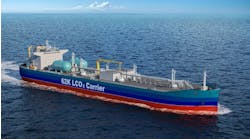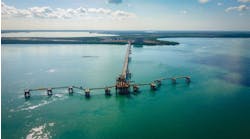Stefano di Vincenzo
Eni E&P
Michele Arena
Schlumberger
Deepwater development presents many challenges, from drilling to completion to production. This is the story of an extremely complex set of challenges that were addressed successfully offshore Nigeria, returning significant benefits to the operator in the form of an increase in net present value of 15% and an increase in overall reservoir recovery factor of 6%.
Setting the scene
About 37 miles (60 km) offshore Nigeria, in about 2,132 ft (650 m) of water, several turbidite sand lobes located at different levels constitute a high-permeability reservoir with numerous mud-filled channels providing potential isolating barriers. The reservoir consists of a northern lobe and a southern lobe, subdivided in three levels, A, B, and C. A total of eight wells were drilled initially, all targeting level A. Wells 1, 2, 3, 5 and 6 terminated in the northern lobe and wells 4 and 7 terminated in the southern lobe. In 2005, an eighth well was drilled that, while targeting level A, also penetrated levels B and C, confirming the complex nature of the reservoir and calling for a reassessment of completion options.
The team was faced with several challenges, both technical and legal. Under Nigerian law, each zone in a multi-zone completion must be isolated and monitored. On the technical side, sand management and crossflow were the major issues.
After appropriate engineering study, the following objectives and challenges were identified:
- Well control—three fully separated, monitored and controlled zones were to be deployed in a single completion run.
- Equipment clearance—very tight clearances between upper and lower completion units and between tubulars were expected.
- Zonal allocation—Downhole zonal allocation must comply with Nigerian law.
- Zonal isolation—high integrity isolation was required for selective isolation and control.
- Well position—water depth required a dynamically positioned rig.
The first step was to see if a single-well intelligent well systems (IWS) completion was technically possible, given the constraints posed by the reservoir conditions, the dimensions of available completion equipment and compliance with the law. If the first step was deemed to be feasible, the second step would compare different alternatives to evaluate economics.
Attention to detail facilitates decision
During the evaluation phase, and before the final completion decision was taken, the team was faced with a complex set of economic and technical alternatives. Initially, the plan was to consider only existing technologies applied to three single-zone horizontal open hole gravel pack completions and dual-zone cased hole gravel pack completions. As third option there was the new technologies applied to a single deviated well completed with triple IWS and frac pack for sand management. The well would produce commingled from all three isolated levels, with precise downhole monitoring of each level to comply with Nigerian law.
After some study, the Base Case was removed from consideration because of problems experienced in previous wells with open hole gravel pack completions. Thus, alternatives 1 and 2 were all that remained. To make the project profitable in the long term, a gas injector completion was added. Accordingly, the final decision was between the following alternative scenarios:
Alternative No. 1 (four wells)
- One single producer (level B)
- One dual zone producer with IWS (levels A and C)
- One dual zone producer with IWS (levels A and B)
- One triple zone gas injector (levels A, B, and C commingled).
Alternative No. 2 (three wells)
- One triple zone producer with IWS (levels A, B, and C)
- One dual zone producer with IWS (levels A and B)
- One triple zone gas injector with IWS (levels A, B, and C commingled).
First step – Completion design feasibility
Working as a team to ensure engineering and operational compatibility, operator and Schlumberger engineers developed a triple upper zone IWS completion with a lower zone stacked packed gravel pack completion. The lower completion consisted of three independent stacked packed gravel pack assemblies, each with an isolation packer to separate them from each other, a gravel pack circulation sleeve to allow zonal fluid returns during pack installation, and 7-in. wire-wrapped screens to isolate the gravel in the annulus.
The upper completion consists of two 2 7/8-in. flow-control valves with pressure gauges. These are run inside the lower completion to control flow from the middle and lower zones. In addition, a 3 ½-in. flow-control valve and gauges are run above the lower completion to control production from the upper zone.
Second step – Decision factors weighed
The final decision boiled down to one of implementation cost, or CAPEX, followed by the net present value of expected incremental production. This, too, had its complexities. Capex for a triple zone IWS cost 35% more than that of a dual zone IWS. In addition, capex for the contract engineering required to integrate sand management media amounted to a 15% increase. Finally, well capex required to install the triple zone completion added 23% to the overall cost.
On the other hand, expected incremental production for the triple zone completion versus the dual zone completion was more than 1 MMbbl.
When the total field development solution was taken into account, alternative No. 2 offered some very attractive benefits. Drilling one less well would save about $24 million. A complete subsea facility equipment and installation cost for one well would be saved. Production from level C would be controlled with concurrent ability to exercise conformance and depletion control. It should be noted that these benefits assumed the IWS would perform reliably.
The main advantages of the option chosen are as follow:
- Reduced capex—One well to drill and complete, versus the other options.
- Increased production—Additional production was expected due to gas lifting from level A helping to lift production from levels B and C.
- Zonal control—Provides the ability to react to premature water breakthrough or early depletion of a zone.
Alternative 2 implementation
Seven-inch sand screens were selected over 6 5/8-in. screens despite the fact that clearance between the 9 5/8-in. casing and the screens was less than 1 in. This was because the added strength of the larger screens was deemed significant during run-in and later when the well was put on production.
All flow-control valves were checked to ensure their operating range accommodated the expected production profiles for each valve aperture position and achieved optimum drawdown.
Flow diagram illustrates how each zone flows through the completion to its ultimate commingling at the top. [SOURCE: SPE 133080 Figure 8].
A 6-in. multi-ported bonded seal assembly isolated the two lower zones while allowing passage of hydraulic and electrical control and telemetry lines for the flow-control valve and gauges. To protect the control lines, grooved blast joints were positioned opposite each perforated interval. These featured self-aligning connections that aligned the grooves within 0.01-in. (0.25 mm) when the connections were made up so the lines were protected across several joints.
Radial clearance between flow-control valves and the sand screens was 0.851-in. considered sufficient to prevent damage to the control lines and prevent swabbing during upper completion run-in. This also allowed circulation during stab-in.
Flow path through the completion shows how each zone’s production makes its way through the completion. Each zone’s contribution is controlled and monitored using the IWS control-valves and gauges before it is commingled for its ultimate journey to the surface production facility.
To ensure long-term reliability, engineers were careful to avoid placing flow-control valves opposite perforations. This affected completion equipment length for each zone, which was 15-ft (4.5 m) for level A, 43-ft (13 m) for level B and 34-ft (10.5 m) for level C. The interval distance between layers was 102-ft (31 m) between the bottom of level A and the top of level B, and 105-ft (32 m) from the bottom of level B to the top of level C. The well’s maximum deviation of 32.5° with a maximum dogleg severity of 3.1°/100-ft was considered adequate to avoid problems during run-in or gravel packing operations, or subsequently during the life of the reservoir.
Results exceed expectations
Planned versus actual costs for alternative No. 2 were encouraging. For the well drilled with the triple IWS completion and the well drilled with the dual IWS completion, IWS material capex came in as planned at 35%; IWS service capex was less than 12.5% versus the plan of 15%; and the overall well capex difference was reduced to less than 6% against the planned 23%.
On the production side, cumulative oil produced reached normally expected levels seven months ahead of time and six months ahead of the most optimistic expectations. The AFE was re-paid within 15 months of production; net present value of the well increased by 15% and reservoir recovery factor was calculated to have risen from 24.7% to 31.05%.
Offshore Articles Archives
View Oil and Gas Articles on PennEnergy.com







